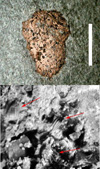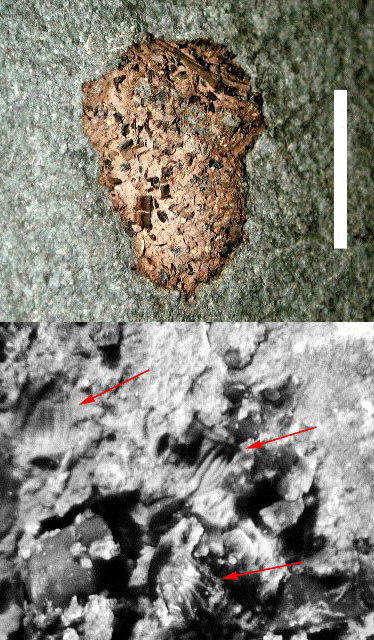Coprolites
Any biologist will tell you that an easy way to know what an animal ate is to analyze its excrement.
 (88 kb) Excrement can be fossilized, and there is a lot of it in the Escuminac Formation! Fossilized excrement is called coprolite, from the Greek kopros for excrement, and lithos for stone.
(88 kb) Excrement can be fossilized, and there is a lot of it in the Escuminac Formation! Fossilized excrement is called coprolite, from the Greek kopros for excrement, and lithos for stone.
Often in the shape of thin cylinders, the longest coprolites in the Escuminac Formation are more than 7 cm in length, with a diameter of 1.5 cm. The analysis of these remains, even if it is impossible to determine what animal left them, offers valuable information about the relationships between the ancient animals that lived at Miguasha. Most of the coprolites discovered thus far are pieces of acanthodians (scales, spines and bone fragments). By measuring the scales, paleontologists have discovered that there was a certain preference for prey based on size: individuals measuring 10 to 20 cm long had the greatest risk of being consumed, while those shorter than 10 cm, or longer than 20 cm, were generally spared.
Again according to coprolites, the second most commonly preyed upon group was the sarcopterygians, although the small size of the scales suggests that only young individuals were eaten. Next on the menu came the actinopterygians, followed by Asmusia. The latter was a small crustacean, and although seldom seen in coprolites, it appears to have been consumed by predators of all sizes, as attested by the presence of its little valves in excrement big and small. It seems that everyone enjoyed a little sprinkling of Asmusia now and then!

 (88 kb) Excrement can be fossilized, and there is a lot of it in the Escuminac Formation! Fossilized excrement is called coprolite, from the Greek kopros for excrement, and lithos for stone.
(88 kb) Excrement can be fossilized, and there is a lot of it in the Escuminac Formation! Fossilized excrement is called coprolite, from the Greek kopros for excrement, and lithos for stone.Often in the shape of thin cylinders, the longest coprolites in the Escuminac Formation are more than 7 cm in length, with a diameter of 1.5 cm. The analysis of these remains, even if it is impossible to determine what animal left them, offers valuable information about the relationships between the ancient animals that lived at Miguasha. Most of the coprolites discovered thus far are pieces of acanthodians (scales, spines and bone fragments). By measuring the scales, paleontologists have discovered that there was a certain preference for prey based on size: individuals measuring 10 to 20 cm long had the greatest risk of being consumed, while those shorter than 10 cm, or longer than 20 cm, were generally spared.
Again according to coprolites, the second most commonly preyed upon group was the sarcopterygians, although the small size of the scales suggests that only young individuals were eaten. Next on the menu came the actinopterygians, followed by Asmusia. The latter was a small crustacean, and although seldom seen in coprolites, it appears to have been consumed by predators of all sizes, as attested by the presence of its little valves in excrement big and small. It seems that everyone enjoyed a little sprinkling of Asmusia now and then!
Site map | Feedback | Links | Sources | Credits
Coprolites
<< Stomach contents | Invertebrates >>

Title: Coprolithe
Author: Parc national de Miguasha
Sources: Parc national de Miguasha
Year: 2007
Description:
A coprolite from the Escuminac Formation. The top image shows several dark bone fragments (vertical bar is 1 cm). The lower image is an enlarged portion of the same coprolite in which scales of the actinopterygian Cheirolepis canadensis are visible (arrows).


